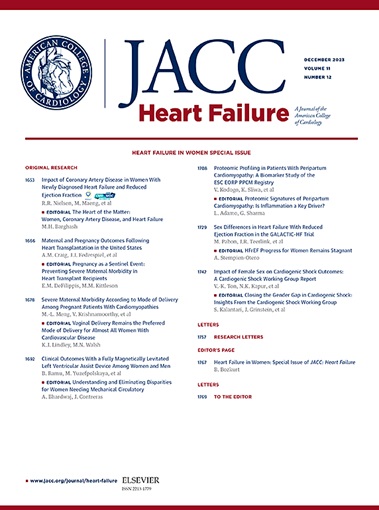Global Burden and Disparities in Pediatric Heart Failure
IF 11.8
1区 医学
Q1 CARDIAC & CARDIOVASCULAR SYSTEMS
引用次数: 0
Abstract
Background
Heart failure (HF) is a major global health threat; however, the disease burden of pediatric heart failure (PHF) remains poorly understood.
Objectives
This study aimed to comprehensively assess the global burden of PHF using the GBD (Global Burden of Disease) 2021 study.
Methods
Data for PHF (0-20 years) were analyzed to estimate the prevalence, years lived with disability, and estimated annual percentage changes, stratified by age, gender, region, country, and sociodemographic index.
Results
In 2021, the global prevalence of PHF was 6.01 million cases (rate: 228 per 100,000). The prevalence rate increased by 8.78% from 1990 to 2021, with significant differences observed by gender, age, country and region. A positive correlation between sociodemographic index and PHF prevalence was observed (P < 0.001). The leading causes of PHF were congenital heart anomalies, other cardiomyopathies, rheumatic heart disease, and chronic kidney disease, with varying trends over time. The increase in years lived with disability mirrored the change in prevalence, forecasting a consistent upward trend in the disease burden of PHF by 2050.
Conclusions
This study underscores the growing burden of PHF and the urgent need for targeted interventions to alleviate its impact. It highlights the importance of addressing geographical disparities and factors such as gender, age, and underlying causes. To mitigate the impact of PHF on children's health, there is a need to draw lessons from successful regions, promote focused clinical and mechanistic research, and develop more effective prevention and treatment strategies.
儿童心力衰竭的全球负担和差异
心衰(HF)是一个主要的全球健康威胁;然而,儿童心力衰竭(PHF)的疾病负担仍然知之甚少。本研究旨在通过GBD(全球疾病负担)2021研究全面评估PHF的全球负担。方法对PHF(0-20岁)的数据进行分析,以估计患病率、残疾生活年数和估计的年百分比变化,并按年龄、性别、地区、国家和社会人口指数分层。结果2021年,全球PHF患病率为601万例(发病率:228 / 10万)。从1990年到2021年,患病率上升了8.78%,性别、年龄、国家和地区之间存在显著差异。社会人口学指数与PHF患病率呈正相关(P <;0.001)。PHF的主要原因是先天性心脏异常、其他心肌病、风湿性心脏病和慢性肾脏疾病,随时间变化趋势不同。残疾生活年数的增加反映了患病率的变化,预测到2050年PHF的疾病负担将持续上升。结论本研究强调了PHF负担日益加重,迫切需要采取有针对性的干预措施来减轻其影响。它强调了解决地域差异和性别、年龄等因素及其根本原因的重要性。为了减轻PHF对儿童健康的影响,需要吸取成功地区的经验教训,促进有重点的临床和机制研究,并制定更有效的预防和治疗战略。
本文章由计算机程序翻译,如有差异,请以英文原文为准。
求助全文
约1分钟内获得全文
求助全文
来源期刊

JACC. Heart failure
CARDIAC & CARDIOVASCULAR SYSTEMS-
CiteScore
21.20
自引率
2.30%
发文量
164
期刊介绍:
JACC: Heart Failure publishes crucial findings on the pathophysiology, diagnosis, treatment, and care of heart failure patients. The goal is to enhance understanding through timely scientific communication on disease, clinical trials, outcomes, and therapeutic advances. The Journal fosters interdisciplinary connections with neuroscience, pulmonary medicine, nephrology, electrophysiology, and surgery related to heart failure. It also covers articles on pharmacogenetics, biomarkers, and metabolomics.
 求助内容:
求助内容: 应助结果提醒方式:
应助结果提醒方式:


